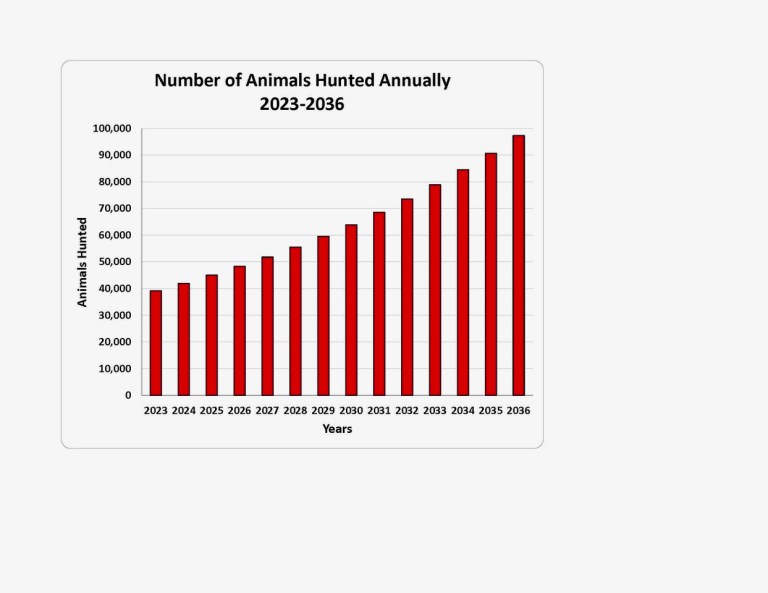Ramaphosa and Creecy defend controversial ‘biodiversity business’ plan
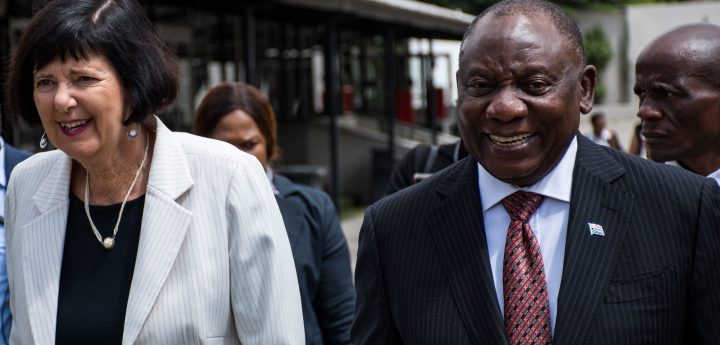
Forestry Fisheries and Environment Minister Barbara Creecy (left) with President Cyril Ramaphosa at the biodiversity economy exhibition at the Biodiversity Economy and Investment Indaba, Boksburg, on 26 March 2024. (Photo: Julia Evans)
By Julia Evans | 27 Mar 2024
At the Biodiversity Economy and Investment Indaba in Johannesburg this week, Environment Minister Barbara Creecy and President Cyril Ramaphosa highlighted the benefits of their ambitious National Biodiversity Economy Strategy, which has drawn criticism.
___________________________________________________________________________________________________________________________
‘When one goes to rural areas, you just often get so sad to look at rural areas that you can see are just dormitories where people live, with hardly much economic activity that happens.
“And yet lying hidden, like Rembrandts lying in the attic, are the endowments our people should now utilise – the land, the plants, and everything else that is in our rural communities,” President Cyril Ramaphosa told the Biodiversity Economy and Investment Indaba at the Birchwood Hotel and Conference Centre in Boksburg on Tuesday.
“Those need to be brought to life. That is the residual capital that we have that needs to be utilised.”
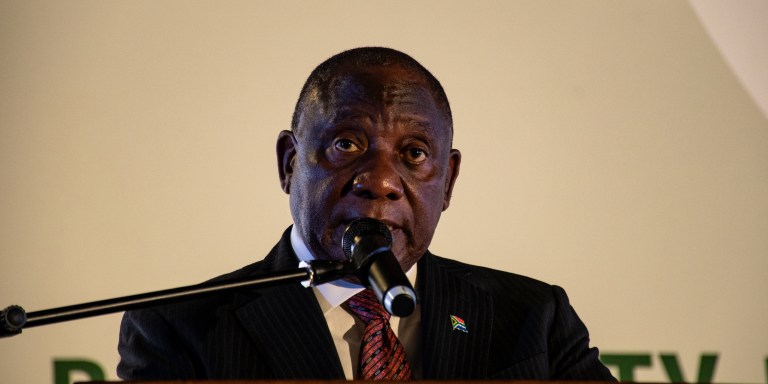
President Cyril Ramaphosa addresses the Biodiversity Economy and Investment Indaba at the Birchwood Hotel and Conference Centre in Boksburg. (Photo: Julia Evans)
The indaba, hosted by the Department of Forestry, Fisheries and the Environment (DFFE), brought together government officials, traditional leaders and healers, academia, business, communities and conservation management authorities to discuss the biodiversity sector’s contribution to the alleviation of poverty, unemployment and inequality, and to pitch biodiversity business concepts to potential investors.
“Over 100 proposals will be pitched to investors,” DFFE Minister Barbara Creecy said at the opening of the three-day indaba on Monday.
“I am hoping that many of these projects will be picked up and come to fruition. I can assure you that the government will support and facilitate their success.”
Central to discussions at the indaba was the controversial draft of the National Biodiversity Economy Strategy (NBES), published for public comment by Creecy earlier this month.
The strategy is aligned with the goals of the White Paper on Conservation and Sustainable Use of South Africa’s Biodiversity and aims to leverage the biodiversity economy to promote conservation, and species and ecosystems management.
Following the release, Don Pinnock wrote in Daily Maverick that while the strategy draft appears to favour the conservation of wildlife and massively extend areas of protection, by embracing consumptive use, the strategy cuts across the advances made by Creecy and her department regarding the welfare of wild animals, her stand against captive-bred lions, the progressive findings of the high-level panel on lions, elephants, rhinos and leopards, and the White Paper on Conservation and Sustainable Use.
Read more in Daily Maverick: Government trying to slam through plan that will result in massive exploitation of wildlife
You can read it in the article above this one
Pinnock also noted, “The redistribution and protection of reclaimed areas and redistributed land has not fared well in South Africa and often devolves into squabbles between claimants and rural groups. It tends to be insufficiently policed and is often plundered.”
Creecy told Daily Maverick at the indaba that this perspective was a “misreading” of the strategy.
“The problem is we’ve had two historically diverging schools of thought. The one school has said, ‘In order to have conservation, you look and you don’t touch,’ ” said Creecy. “And the other school of thought has said, ‘There’s biodiversity, let’s utilise it.’ ”
In her keynote address, Creecy noted that the white paper identified the challenge that “inappropriate and illegal practices have on South Africa’s reputation as a world leader in biodiversity conservation.
“As such, the white paper also emphasises the importance of the duty of care, and ensuring the wellbeing of animals and nature more broadly.”
Hunting
Pinnock noted that the plan would “make South Africa one of the world’s top destinations for trophy hunters at a time when that practice is coming under increasing disapproval internationally. This could have a negative impact on brand South Africa and international tourism.”
“Will there be consumptive use in certain situations? Yes,” Creecy told Daily Maverick.
“I mean, hunting is a big industry, and whatever everyone’s subjective views are about hunting, one cannot detract from the fact that hunting contributes an enormous amount of income [to] conservation.”
Creecy said all protected areas cull animals.
“Of course, these are not things that ecotourism ever shares… You don’t come to the Kruger Park to watch the culling of impala, but it happens.
“What we’re saying is, if you were to have extensive herds of game on areas that are currently marginal for conventional agriculture, this land would be compatible with conservation, with ecosystem restoration, and you would be finding a sustainable offtake,” said Creecy.
“So we’re not talking about putting impala in feedlots. We’re talking about extensive systems with commensurate offtake.”
Biotrade and bioprospecting
An exhibition at the indaba showcased market-ready biodiversity products and services from across the biodiversity economy value chains, such as biotrade and bioprospecting — which is the processing of indigenous plants into consumer products.
“The trade in indigenous medicine plants is a multimillion-rand industry that supports jobs and livelihoods across the value chain,” Ramaphosa said during his address.
“As a country, we have been firm that communities must benefit in a tangible manner when plant and animal species are harvested for commercial gain.”
He said that four years ago, the first industry-wide benefits-sharing agreement was launched between the South African rooibos industry and the Khoi and San councils.
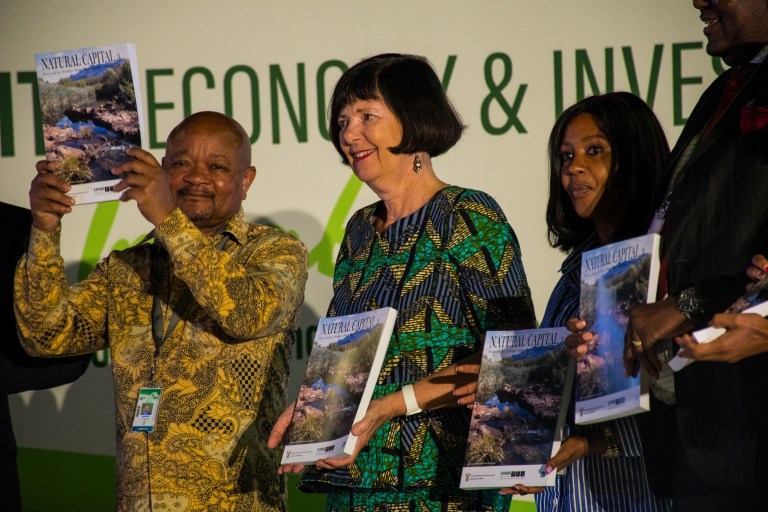
Water and Sanitation Minister Senzo Mchunu (left) with Minister of Forestry, Fisheries and the Environment Barbara Creecy hold the National Capital Accounting books for strategic water sources in SA, prepared by the Statistician General. (Photo: Julia Evans)
This agreement had to date distributed R28-million to the two councils in recognition of the communities’ indigenous knowledge of the rooibos species, Ramaphosa said.
Wolande le Roux, an exhibitor at the indaba selling Sceletia Honeybush Tea, said she was glad Ramaphosa mentioned rooibos in his speech, because in Eastern Cape there was almost no capacity for communities to enter the rooibos and honeybush processing value chain, unlike Western Cape where the provincial government offered support.
Le Roux, who works with communities in Tsitsikamma and Gqeberha and is passionate about indigenous knowledge (being a descendant of the Khoi people), said that in the honeybush market, most local people were harvesters. There were hardly any indigenous people processing the raw honeybush into a commercial product, where most of the money was.
“The support that indigenous communities need, especially Khoi and San people, from the government is to transform from being just a labourer or harvester into getting into the processing value chain,” Le Roux said.
“There are so many byproducts that can come from honeybush,” Le Roux said, from herbal remedies to skincare products.
“But you need to capitalise the local communities — create awareness of the opportunities, then train them and give them the necessary skills and then give them the financial or technical support.”
An indigenous company that has received harvesting training from the DFFE is Mazoyi Group, in Alice, Eastern Cape. It processes indigenous aloe and Pelargonium plants into a range of medicines.
Its CEO and founder, Lwazi Marawu, who commercialised the indigenous healing practice that his great-grandmother started in her community in 1906, acknowledged that while the DFFE’s training on harvesting was good, they needed more training on the business side.
Ramaphosa said in his address that approximately R2-million had been paid to traditional authorities in the Eastern Cape, Northern Cape, North West, KwaZulu-Natal and Limpopo in recognition of indigenous knowledge associated with plants like aloe, Sceletium, marula, Pelargonium and buchu.
“We know that compensation in recognition of indigenous knowledge held by communities is not enough,” said Ramaphosa. “We know that payment to communities for harvesting these species is also not enough.
“There must be tangible beneficiation in communities when indigenous plant species are harvested for commercial benefit.”
“It’s a very grand plan… I can see how it’s contributing to the economy and commercialisation, but I’m not seeing how it contributes toward conservation,” Le Roux said.
Land use in rural communities
“It cannot be business as usual,” said Creecy, speaking of the need to include rural communities and previously disadvantaged individuals in the biodiversity economy.
That would require investment into community-owned land for conservation-compatible land use with biodiversity enterprises.
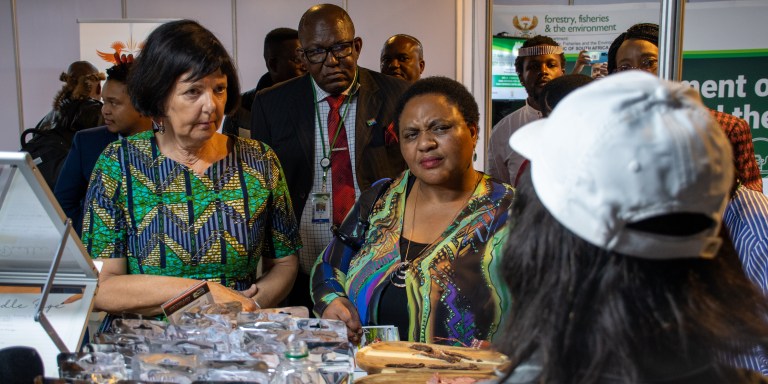
Forestry Fisheries and Environment Minister Barbara Creecy (left) and Agriculture, Land Reform and Rural Development Minister Thoko Didiza listen to a vendor at the biodiversity economy exhibition. (Photo: Julia Evans)
Agriculture, Land Reform and Rural Development Minister Thoko Didiza noted in her address at the indaba on Monday that land-use changes were not optimally managed in rural areas, and could create conflicts between the environment, culture and development.
“As the population grows, so does the need for alternative land use for housing, agriculture and other developments,” Didiza said. “This is the reality and the balancing act that we must always uphold.”
Assisting communities with land for development, in tandem with protecting nature and wildlife, would make communities value nature and actively engage in the protection of biodiversity, Didiza said.
International standards
South Africa adopted the Kunming-Montreal Global Biodiversity Framework, at the last UN Biodiversity Conference in 2022.
The headline target is the “30×30”, which aims to effectively conserve at least 30% of the world’s land, freshwater and oceans by 2030, while also respecting the rights and contributions of indigenous peoples and local communities.
Creecy said SA needed to domesticate the global agreement, and the white paper was a mechanism for doing so, as was the revised National Biodiversity Economy Strategy. She said the strategy was in line with international policy and thought.
“If we’re going to get anywhere near 30% of the land target, we are going to have to deeply interrogate a question of sustainable use,” Creecy said.
“What we know is, that at the moment, conservation is either done by government or by private landowners, the majority of whom [are] historically privileged South Africans.
“We think that there is significant land in our country that belongs to traditional authority, and to community property associations that can enjoy some form of protection and ecosystem restoration, and still have a sustainable offtake that could benefit those communities.”
Creecy said that to achieve the 30×30 target, the state would need the help of the private sector. DM



